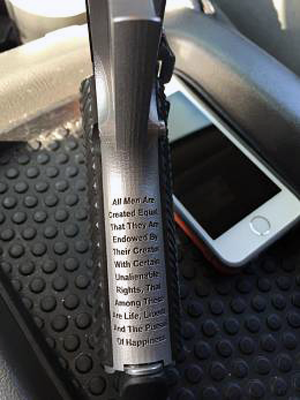After having created the first firearm 3D printed in metal, in November of last year, 3D printing service bureau and recently acquired Stratasys subsidiary Solid Concepts has created a sequel. Following up their 1911 3D printed pistol, the subsidiary has 3D printed a new pistol design, the Reason. Unlike their previous model, however, this gun was not made specifically as a product of Solid Concepts, but as a one-off for the subsidiary’s Firearms Project Manager, Eric Mutchler, according to Reason.
The 1911, a limited series of a classic pistol designed by John Browning, was made via the direct metal laser sintering (DMLS) of 17-4 Stainless Steel and Inconel 625 powder. The 1911 has been fired about 5,000 times without issue, proving it to be much more robust than the plastic Liberator pistol from Defense Distributed or those created by Yoshitomo Imura, who was sentenced to two years in jail about a week ago. Produced as a limited production run of 100 pieces, the 1911 had a price tag of $11,900 each.

The thought may or may not cross your mind: why would anyone need a customized gun, aside from reasons of vanity? In a future of mass-customization, in which electronic components could be printed directly into objects, guns could be tailored to the individual, even so far as to include safety features that ensure that only the gun’s owner can fire it, via a finger print recognition mechanism. More immediately, 3D printing gun parts could be used by the military and other armed forces.
Kent Firestone, Vice President of Additive Manufacturing at Solid Concepts, said of the 1911 printed last year, “We’re proving this is possible, the technology is at a place now where we can manufacture a gun with 3D Metal Printing. Now, if a qualifying customer needs a unique gun part in five days, we can deliver.” One possible qualifying customer could be the US military, which is in the process of developing on-the-field manufacturing capabilities. Mobile fab labs would allow soldiers to 3D print replacement components for damaged equipment close to the field of battle, maintaining the longevity of the equipment and reducing the amount of time it would take to obtain replacement parts shipped from farther away. Once this is perfected, it could even be possible for the military or a militarized police force to create custom weapons, on demand, for a specific purposes, with barrels or sights that are designed, on the spot, for a unique scenario.
As for Mutchler’s own reason for 3D printing the gun, he tells Reason that it was just his own personal example of interesting possibilities of personalized weapons only possible with metal 3D printing. The name of the gun, Multcher explains, is not an act of fanship for the libertarian magazine, but “for the sake of it, it seemed a useful term” for his gun. After all, “who can argue with ‘reason’?”
Whether or not Solid Concepts will print its own line of weaponry again in the future is unclear, but Multcher has clarified with Reason that his own firearm is unrelated to his employer’s projects.



